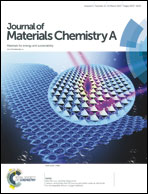2D MoS2/polyaniline heterostructures with enlarged interlayer spacing for superior lithium and sodium storage†
Abstract
The exploitation of high-capacity and long-life MoS2-based materials is highly important for developing lithium ion batteries (LIBs) and sodium ion batteries (SIBs). Herein, we demonstrate the confined synthesis of 2D MoS2/polyaniline (MoS2/PANI) nanosheet heterostructures with well-defined interfaces, in which the interlayer distance of MoS2 is greatly enlarged from 0.62 nm to 1.08 nm. The introduction of such a big interlayer distance for efficient Li+/Na+ storage has never been demonstrated before. The unique MoS2/PANI nanosheets can address well the key challenges of traditional MoS2 anode materials related to low conductivity particularly in the vertical direction, easy restacking/aggregation, large volumetric change and sluggish Li+/Na+ diffusion kinetics in the interlamination. Consequently, they deliver a high reversible capacity, superior rate capability and long cycle life for both LIBs and SIBs. A state-of-the-art ab initio molecular dynamics (AIMD) simulation also reveals that MoS2/PANI nanosheets with enlarged interlayer spacing possess a remarkably improved Li+/Na+ diffusion mobility compared to pristine MoS2 nanosheets. The present material design concept opens new directions for finding efficient LIBs/SIBs anodes with high capacity, rate capability and stability.



 Please wait while we load your content...
Please wait while we load your content...